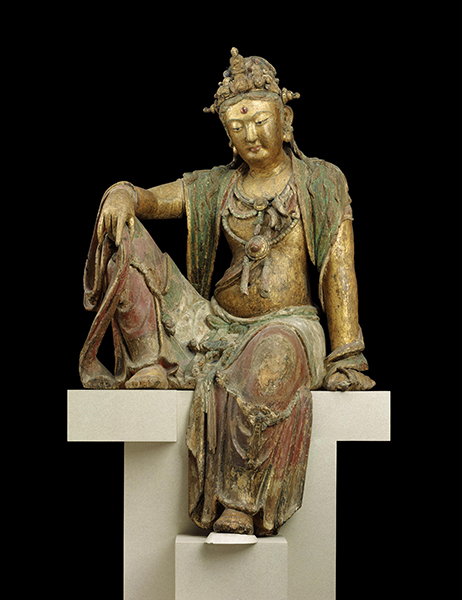Gem of the Month: Guanyin
Seated in the “position of royal ease” (rajalilasana in Hindu), this portrayal of the bodhisattva Guanyin mirrors hundreds of other versions of the subject in Chinese art. The pose was influenced by Indian sculptures of Vishnu in the same configuration, but Chinese versions of the pose from the Song dynasty (960–1279/1280) are by far among the most elegant, beautiful works in the genre.
 |
| Song dynasty, China, Guanyin, 1100s. Wood with traces of pigment and gold leaf, 55 ½" x 34 5/8" x 34 5/8" (141 x 88 x 88 cm). © 2021 Museum of Fine Arts, Boston. (MFAB-633) |
Song artists continued the Tang dynasty (618–907) tradition of plump, beautiful figures for Buddha and bodhisattva representations, the so-called "Tang ideal beauty." This androgyny was especially fitting for depictions of the bodhisattva Guanyin (Kanon in Japan), the bodhisattva of mercy who embodies both female and male attributes (something akin to Siva, “the lord whose half is woman”). Bodhisattvas—those who have achieved enlightenment but choose to remain in the physical world to help mortals—became figures of worship/meditation themselves during the Tang period and remain so to the present day. The stylistic vocabulary of these figures established in the Tang period also endures.
The "position of royal ease," a pose that evolved during the 800s CE in China, emphasizes that moments of ease are the most fruitful for meditation. The right hand resting on the bent knee is in the mudra (hand gesture) of blessing giving. The circular urna on the forehead—also seen in figures of the Buddha—is symbolic of an enlightened being. The seated Buddha in the bodhisattva's crown represents the Amithaba of Pure Land (Western Paradise) Buddhism.
The increased emphasis on realism in Tang art is reflected in the attention to detail paid to the costume of this Song dynasty bodhisattva sculpture. Figures such as this were often decorated further in temples with garlands of flowers and jewelry. The “Tang ideal of beauty” evolved during the 700s CE when the idea of the epitome of feminine beauty changed from tall and slender to more full-figured, appearing first in the form of female attendant tomb figures. Some scholars have attributed this aesthetic to the popular appeal of Yang Guifei, a favorite consort of the Xuanzong Emperor (713–756 CE).
Song artists refined and expanded Tang aesthetics, particularly in realism, which reached its peak in sculpture during the Song dynasty. Although Song realism lacks the vitality of Tang works, there is a greater emphasis on monumentality of form, particularly in sculpture, that continued to fill the need for imagery in the various sects of Buddhism. The Western Paradise (Pure Land, Buddha Amitabha) sect had already described in great detail an afterlife in very sumptuous earthly terms.
The Song dynasty is considered one of the most significant periods of cultural and artistic development in Chinese history. It was a period of tremendous pressure by various cultures outside of China in the north, with the constant threat of invasion. Northern China fell to invaders who established the Jin Song dynasty (1115–1234), and after 1127 the Song ruled only south of the Yangtze River. The Song dynasty collapsed when the Mongols invaded China, first taking the northern dynasty (1211) and ultimately defeating the Song fleet in 1279.
Correlations to Davis Programs: Discovering Art History 4E: 4.3


Comments